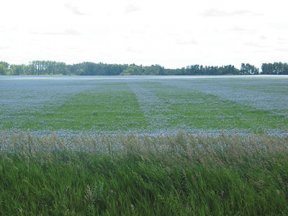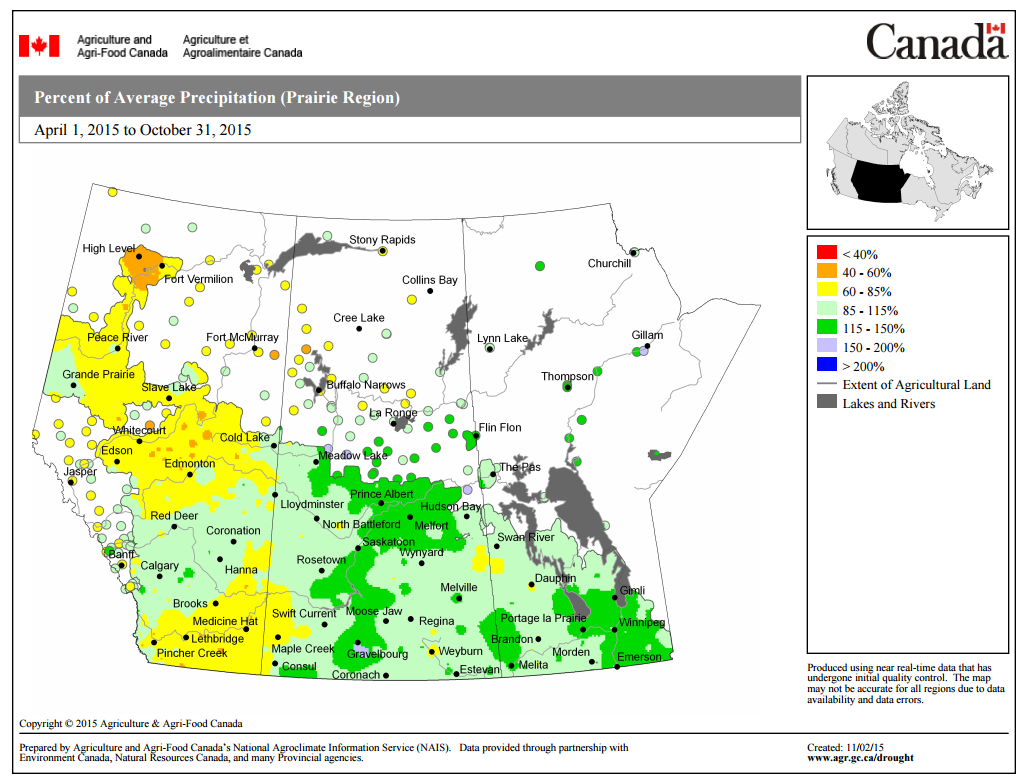Flax TIPS: Crop Rotation
Crop rotation is an important management tool that has been shown to affect nutrient uptake and impact soil moisture availability. In rotation, flax can also break up disease and pest cycles of other crops. As flax has a relatively shallow rooting depth (70 cm), soil moisture remains available below this depth for subsequent crops that are more deeply rooted.
Choosing Stubble
The table below is adapted from Manitoba Agricultural Services Corporation (MASC) and indicates yield of crops grown on various stubble.
Table 1: Yield response (% 2000-2012 average yields) of Manitoba crops sown on various stubble
| Crop Planted | ||||||
|---|---|---|---|---|---|---|
| Previous Crop | Spring Wheat | Barley | Oat | Canola | Flax | Soybean |
| Spring Wheat | 88 | 100 | 101 | 104 | 103 | 102 |
| Barley | 90 | 87 | 93 | 100 | 98 | 95 |
| Oat | 89 | 87 | 84 | 92 | 95 | 104 |
| Canola | 103 | 105 | 104 | 84 | 88 | 102 |
| Flax | 96 | 106 | 99 | 100 | 77 | 89 |
| Soybean | 105 | 107 | 102 | 87 | 99 | 104 |
| Yield (bu/ac) | 43 | 61 | 88 | 32 | 20 | 28 |
Source: MASC Harvested Acreage Reports (2000-2012) from Manitoba contract holders
From the table, some of the key things to consider when planning what stubble to plant your flax on are:
Avoid Canola Stubble, but Go for Cereals! Yields are lower (88% of average stubble yield) when flax is sown on canola stubble. The main reason involves arbuscular mycorrhizal fungi (AMF), which are symbiotic soil fungi that enhance early season uptake of phosphorus. When canola is grown, AMF are not needed, so AMF populations decline. So if you seed flax on canola stubble, early season phosphorus uptake by the flax crop can be reduced (Fig.1). As cereals do associate with AMF, they are a better stubble seeding option for flax as AMF populations are maintained. A study by AAFC researchers found that flax grown on wheat stubble had improved establishment, early season biomass, phosphorus accumulation and yield, than flax grown on canola stubble (Grant et al. 2009, McGonigle et al. 2011).

Figure 1. Lack of mycorrhizal colonization on flax roots was clearly evident on the canola stubble plots. Photo by Rigas Karamanos.
Avoid Flax on Flax! Yields are lower for most crops when planted on their own stubble. Reduced flax yields can be caused by build-up of disease like fusarium wilt and pasmo, which may infect the next crop earlier and with higher levels of inoculum. As well, as flax is a shallow rooted crop this may leave the soil rooting area dry and subsequent flax crops may be at a disadvantage growing in the dry rooting zone (if in-season rain is limited).
Flax Makes a Great Stubble for the Next Crop! As flax does not share the same diseases as many other crops, it is a good ‘disease break’ crop in the rotation. Also, flax is shallow-rooted, which leaves moisture and nitrogen at lower soil depths for other deeper-rooted crops to access.
Re-Cropping Restrictions with Residual Herbicide
Flax is sensitive to many herbicides, so prior to choosing land for flax production, herbicide residue history should be verified. If the herbicide history of a field is unknown, it is possible to send soil samples to an accredited lab for residue analysis.
Climatic conditions play a considerable role in determining the speed of herbicide breakdown in soils. If conditions have been dry, soil microbial populations can cease all activity, drastically reducing product breakdown. Conversely, if conditions have been excessively wet, this can also slow microbial breakdown as conditions may have become anaerobic. Temperature also plays a significant role in determining the speed of herbicide breakdown. Applying herbicides late in the season after harvest may also reduce herbicide breakdown for the following crop.
Given that soil moisture conditions affect herbicide breakdown, the figure below represents the percent of average precipitation received during the 2015 growing season. Areas in yellow and orange only received 60 – 85 % and 40 – 60 % of average precipitation, respectively. In these regions, producers should be conservative with their re-cropping restrictions for the 2016 growing season.

Source: AAFC Drought Watch (www.agr.gc.ca/drought)
Be sure to consult with your provincial Guide to Crop Protection or your local agronomist for re-cropping restrictions.
For Manitoba’s Guide to Crop Protection: http://www.gov.mb.ca/agriculture/crops/guides-and-publications/pubs/crop-protection-guide-herbicide.pdf
For Saskatchewan’s Guide to Crop Protection:
http://www.agriculture.gov.sk.ca/Default.aspx?DN=d281d596-7317-42f1-ac86-898fa5908d18
For Alberta’s Guide to Crop Protection:
http://www1.agric.gov.ab.ca/$Department/deptdocs.nsf/ba3468a2a8681f69872569d60073fde1/8f417f9cb3ccbcd787256a3800789abc/$FILE/ATTN1G3Z.pdf/606-1.pdf
For more information on herbicide breakdown, visit: http://www.agriculture.gov.sk.ca/Default.aspx?DN=59764a0d-f46f-4288-8464-76d0131a9531
References:
Grant, C. A., M. A. Monreal, R. B. Irvine, R. M. Mohr, D. L. McLaren, M. Khakbazan. 2009. Crop response to current and previous season applications of phosphorus as affected by crop sequence and tillage. Can. J. Plant Sci. 89: 49-66.
McGonigle, T.P., M. Hutton, A. Greenley and R. Karamanos. 2011. Role of Mycorrhiza in a Wheat–Flax versus Canola–Flax Rotation: A Case Study. Communications in Soil Science and Plant Analysis. 42:2134-2142.



